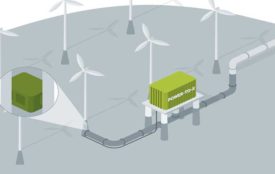Solar glass production without gas with 100 % green electricity
Electricity instead of gas for solar glass production is the order of the day
The gas crisis triggered by the Russian invasion of Ukraine and the reactions of the West with exorbitant price increases have shown how vulnerable our industrial processes are due to dependence on fossil fuels, especially natural gas. This is especially true for the glass industry.
Due to the availability of cheap natural gas, almost all processes in the solar glass value chain are based on it, resulting in extreme dependence. In addition, all fossil combustion processes are harmful to the climate due to CO2 emissions.
Melting technology with gas – cheap (until 2021) with high CO2 emissions
The development of fossil fuel melting furnaces began with the continuous regenerative glass melting furnace invented by Charles William Siemens of Westminster, England in 1872. The regenerative process (preheating of cold combustion air) increased overall efficiency from 10-25% (depending on size) to as high as 50%, and furnaces fired with fuel/oxygen (instead of air) to overall efficiency of up to 60%.
The use of natural gas, whose price used to average only 30% of the cost of electricity, made the process less costly, although the overall efficiency of electrically heated furnaces reached up to 90%. The emission of CO2 and other substances from fossil fuel firing was not an issue until a few years ago. However, with today’s gas prices, energy costs are now higher than electricity.
Electric melting technology – efficient and without CO2 emissions
Few experts are aware that continuous all-electric melting is almost as old as gas-fired regenerative melting. The first electric furnace was built in 1905 according to the design of the Frenchman Sauvageon and was used for the production of window glass. Even small electric furnaces have thermal efficiencies of 70-85%, and specific energy consumption was less than 0.9 kWh/kg over 100 years ago. However, despite many improvements, electric melting has become increasingly unpopular for all bulk glass due to higher costs compared to widely available cheap fossil fuels.
Only the climate crisis and pressure on the carbon footprint have reignited interest in fully or partially (hybrid) electric melting. Alternative energy sources for electricity have helped to lower costs, and reduce CO2 emissions from the combustion process to as low as 0 for fully electric furnaces. The only CO2 remaining is that contained in the batch. All electric melting furnaces can be designed and operated in a variety of ways, depending on the underlying requirements.
Due to the electrical ionic conductivity, all-electric melting is quite suitable for soda-lime flat glass (solar glass).
A central role for solar glass is to achieve a uniform and particularly stable batch layer. On the other hand, this should allow the passage of bubbles rising from the melt (e.g. CO2, SO2). The problem is that to achieve a stable batch layer, the drawing speed can only be varied within a very small range.
If the glass drawing speed is too low, the batch layer becomes thinner and heat losses mean that sufficient refining to ensure high glass qualities is not achieved.
Typically, all-electric melting furnaces have a stable operating window in the range of 80 to 110% of rated capacity.
Electric melting furnaces result in potentially lower capital costs because a smaller furnace volume is used, regenerators are not required, and expensive high-temperature vaults are not needed. In addition, combustion-related gaseous emissions, e.g., CO2, NOx, and dusts, are greatly reduced, resulting in lower capital costs for filtration equipment and lower operating costs.
From an operational perspective, it is positive that less maintenance is required (e.g., to clean regenerators), less volatilization occurs (lower raw material costs), and lower repair costs are experienced.
In addition, efficiency is not as dependent on furnace size and capacity as with fossil-fired furnaces.
However, there are also disadvantages.
Currently, capacities of 250 tons of glass per 24 hours are possible. For larger plants, modular approaches are being discussed and seem to be a viable solution. In addition, the low train flexibility mentioned above, shorter furnace life, and less operator experience negatively impact the use of this technology.
Capacity Consideration
A 250t/d solar glass plant produces a net of about 5 mill sqm of solar glass (3.2 mm thick) per year. This can produce PV modules with a capacity of about 1.25 GWp. The expansion targets published by the EU assume an expansion of PV production capacities in Europe of 30 MWp by 2030. In purely arithmetical terms, this means that more than 20 solar glass plants with 250 t/d each would be needed to cover the demand.
Since the plants described can also be designed in a modular fashion, it is possible, for example, to operate two melting furnaces with a large batch preparation plant and the downstream refining plants. This also has the advantage that different glass thicknesses (e.g. 2 and 3.2 mm) can be produced and production can also continue on one furnace at a time during the “cold repair” required every 8-10 years.
PV power generation on site
Glass production facilities have immense space requirements. The site, including large traffic areas for logistics, usually covers an area of 4 – 5 hectares. On this area, a PV system with up to 6 – 7 MWp can be installed by an intelligent design with solar modules. If other traffic and storage areas in the vicinity are included, up to 10 MWp can be installed. In most locations, all the electricity needed for on-site production can be produced by such a rooftop and ground-mounted system, provided storage facilities are available. In windy locations, additional wind turbines can be installed, resulting in a better consumption balance.
In order to make the vision of solar glass without emissions a reality, GridParity AG is working with glass technologists and investors on a concept to build the world’s first fully electric solar glass production line. This can then be duplicated as a pilot plant at locations close to PV production in Europe.









